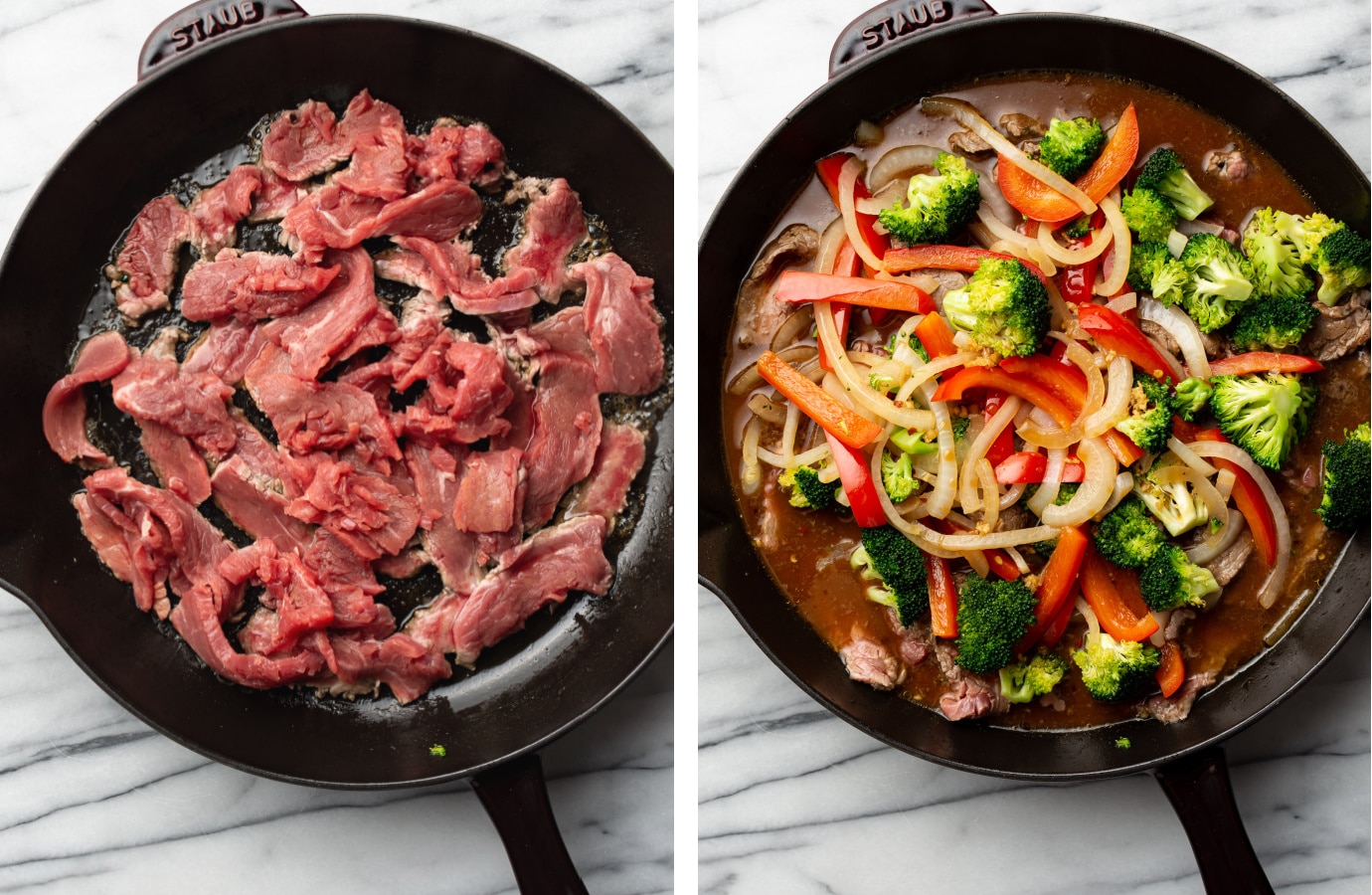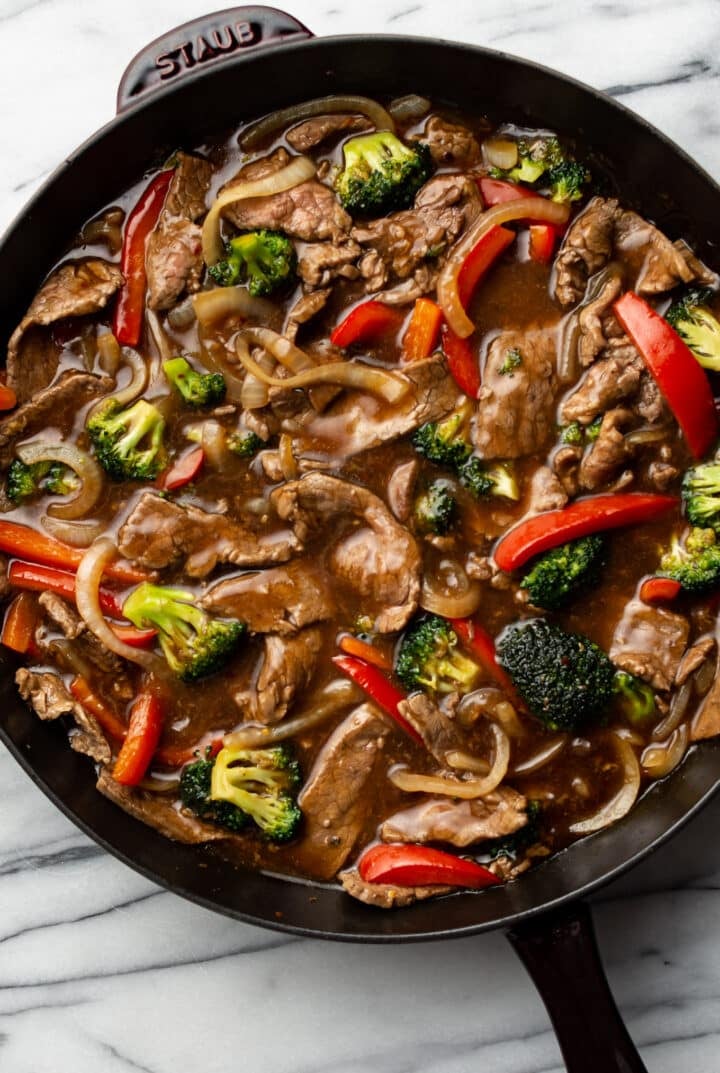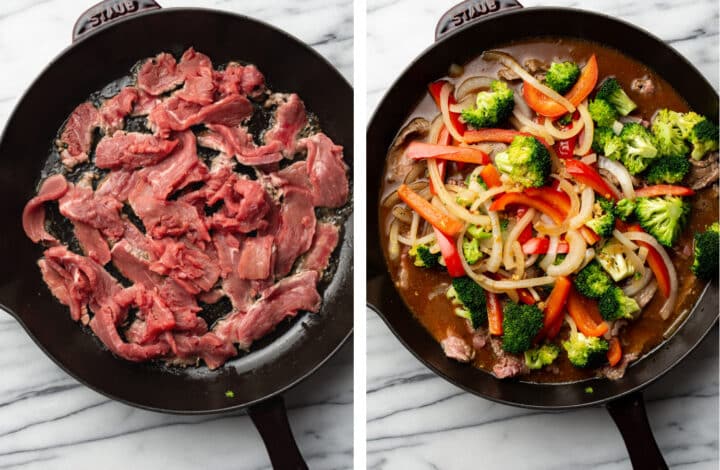Stir frying is a quick and healthy cooking technique that’s popular in many Asian cuisines. By cooking the ingredients in a small amount of oil over high heat, you can create a flavorful dish in minutes. The key to a great stir fry is properly seasoning the meat and vegetables. When it comes to stir frying beef, seasoning is especially important for adding flavor and ensuring the meat comes out juicy and tender.
In this article, we’ll walk through the science of seasoning beef for stir fries and share tips on choosing the right ingredients, marinating techniques, seasoning methods, and more. Follow these best practices for seasoning stir fried beef and you’ll end up with a restaurant-quality meal you can proudly serve to family and friends.
Understanding the Importance of Seasoning
Many novice cooks simply throw unseasoned beef and vegetables into a hot wok with a little oil. While this may produce an edible stir fry, it usually results in bland flavor and dry, chewy meat. Properly seasoning the beef before stir frying is crucial for boosting flavor and texture.
Seasoning works to
-
Enhance the natural flavor of the beef by layering on complementary flavors from spices, sauces, etc.
-
Tenderize the meat by helping break down tough muscle fibers. Acidic marinades and enzymatic fruits like pineapple contain tenderizing properties.
-
Retain moisture so the beef stays juicy when cooked over high heat Salt helps the meat retain natural juices
-
Add texture with crispy spice rubs or velveting techniques that create a thin crispy exterior on the beef.
-
Infuse flavor deep into the meat beyond just the surface Marinating allows seasonings to penetrate into the beef,
Simply put, seasoning is essential for getting the most out of stir fried beef in terms of maximizing flavor and achieving a tender, moist texture.
Choosing the Right Ingredients
Stir fries originated in China but have evolved over centuries as the technique spread across Asia. The seasonings used can vary widely based on regional influences. When choosing ingredients to season beef stir fry, opt for authentic Asian flavors that complement the beef:
-
Soy sauce – This salty, umami-rich sauce adds intense flavor and helps retain moisture. Go for low sodium to avoid over-salting.
-
Rice wine vinegar – Its mild acidity tenderizes meat and adds subtle sweetness. Choose Chinkiang vinegar for authenticity.
-
Toasted sesame oil – A little bit of this aromatic, nutty oil enhances overall flavor. Too much can overpower.
-
Ginger – Fresh ginger packs a spicy, gingery punch. It also aids digestion. Grated is best.
-
Garlic – Minced or crushed garlic provides a pungent aroma and flavor base. Use sparingly to avoid bitterness.
-
Scallions – Offer fresh oniony flavor and crunch. Both green and white parts taste great.
-
Chili paste – Adds spicy heat and complexes flavors. Opt for sambal oelek or Chinese chili paste with garlic.
Marinating the Beef
While you can use a dry seasoning blend, marinating the beef is ideal for maximum flavor infusion. Marinades are typically acidic liquids that help break down meat fibers. Common marinade ingredients like vinegar, citrus, wine, and yogurt provide tenderizing properties. A marinade can be as simple as soy sauce, vinegar, and garlic.
For best results, marinate the beef for 30 minutes up to overnight in the fridge. Any longer than 24 hours and the texture may become mushy. Place beef strips in a sealable bag or dish with the marinade, removing as much air as possible. Let it soak, flipping the bag occasionally. Pat dry before stir frying.
If short on time, you can marinate for just 10-15 minutes. The flavors won’t penetrate as deep, but it’s better than no marinade at all.
Applying a Dry Rub
A dry seasoning blend, or dry rub, is another option for adding big flavor to beef stir fry. Dry rubbing involves coating the raw beef with a mix of ground spices, herbs, salt, pepper, etc. It creates a flavorful exterior crust without penetrative marinating.
To dry rub beef, combine desired seasonings in a bowl, then sprinkle the blend evenly over all surfaces of the raw beef strips. Gently pat and massage the rub into the meat. Let rest 5-10 minutes before stir frying to allow flavors to mingle.
Good dry rub options include five spice powder, paprika, cumin, brown sugar, chili powder, cayenne, garlic powder, ginger powder, etc. Get creative with your own signature rub!
Velveting for Ultra-Tender Meat
Velveting is a Chinese technique that produces super tender stir fried beef by coating it in a marinade that forms a velvety texture. The velveting marinade usually contains cornstarch, egg whites, oil, and seasoning. When cooked, the cornstarch and proteins form a thin gel around the beef keeping it incredibly moist and tender.
To velvet beef, combine 1 tsp cornstarch per lb of beef with 1 egg white and seasoning (soy sauce, rice wine, ginger, garlic, etc). Toss raw beef strips in this slurry until fully coated then marinate for 15-20 minutes. Pat dry and stir fry as usual.
Velveting does require some extra steps, but it’s worth it for melt-in-your-mouth beef texture.
Choosing the Best Cooking Method
Stir frying in a wok or large skillet produces the signature taste and texture, but other cooking methods can also work well when combined with proper seasoning:
-
Pan searing in a hot pan before stir frying adds nice caramelization.
-
Grilling imparts smoky charred flavor from the grill grates.
-
Broiling also chars the meat for robust flavor. Watch closely to avoid burning.
-
Steaming then stir frying creates very tender meat that better absorbs seasoning.
No matter the cooking method, the key is to season the raw beef first before applying heat. This allows the salt, acids, enzymes, etc. to work their magic flavoring and tenderizing the meat.
Putting it All Together
Follow this general process for flawlessly seasoned stir fried beef:
-
Choose your seasoning ingredients based on your flavor preferences.
-
Make a marinade or dry rub, or use a velveting slurry.
-
Add raw beef strips and let marinate 15 minutes to overnight.
-
For a dry rub, simply pat seasoning blend directly onto the raw beef then rest briefly.
-
Cook the beef by stir frying, grilling, pan searing or other method.
-
Stir fry vegetables in batches separately from the beef to avoid overcooking.
-
Toss everything together with any sauce and serve immediately.
Proper seasoning and marinating is really the key to next-level stir fried beef. Master these techniques and you can whip up a restaurant-worthy meal at home any night of the week using simple pantry ingredients. Get creative with marinades and rubs to put your own unique spin on this classic Asian cooking method.
Frequently Asked Questions
What cut of beef works best for stir fry?
- Lean, tender cuts like sirloin, flank steak, skirt steak, or flat iron steak are ideal. They cook quickly and absorb seasoning well.
What if I’m short on time to marinate?
- You can marinate for as little as 15-30 minutes, though overnight is best. A quick soy sauce and garlic marinade is faster than making a complex blend.
Can I skip marinating and just season before cooking?
- Lightly seasoning with salt and pepper before cooking is better than nothing, but marinating really maximizes flavor and tenderness.
What oil should I use when stir frying?
- Opt for a high smoke point oil like avocado, peanut, vegetable, or grapeseed oil. Avoid olive oil as it can burn easily.
Should I pat the beef dry after marinating?
- Yes, blotting excess moisture helps achieve a nice sear and prevents steaming.
What homemade marinades work well?
- Easy combos include soy sauce, ginger, garlic, vinegar, chili paste, hoisin, honey, or sesame oil. Get creative!
With the right seasoning techniques, you can create restaurant-worthy beef stir fries at home using simple ingredients likely already in your pantry.

Tools for this recipe
Check out Natasha’s favorite kitchen essentials, gadgets, and cookware!
- My 12″ Staub skillet is pictured. It’s a good size, and the meat isn’t too crowded in this one. Overcrowded beef will steam vs. fry.
- A Microplane is handy for grating the ginger.
- I like this cutting board. It’s sturdy with plenty of space for chopping the veggies.
- Kitchen tongs make it easy to toss the stir fry.
- You can sub flank steak for sirloin or tenderloin if you like.
- If you want to use frozen broccoli, thaw it first, and you will likely need to cook it for less time as it’s already partially cooked.
- Prefer a sweeter sauce? Add another tablespoon or so of honey.
- This recipe isn’t particularly spicy as written, so feel free to increase the crushed red pepper flakes or leave them out altogether if you want it mild.
- You can definitely change up the veggies, just be sure they’re cut into similar size pieces so they cook at a similar rate (e.g. if adding carrots, slice them very thin or use matchstick cut carrots).

How to make beef stir fry
This is an overview with step-by-step photos. Full ingredients & instructions are in the recipe card below.

Prep all your ingredients. Slice the steak into thin strips. In a mixing bowl, whisk together the stir fry sauce ingredients. Add half the oil to a skillet, and get it sizzling hot. Fry the veggies, tossing often, to desired tenderness. Set aside.

Add the rest of the oil to the skillet, and arrange the beef fairly spread out. Leave it for a minute to cook, then toss and cook for a short while longer. A little rare is ok. Return the veggies to the skillet, and toss with the sauce. Heat until thickened. Serve right away with rice or noodles.
